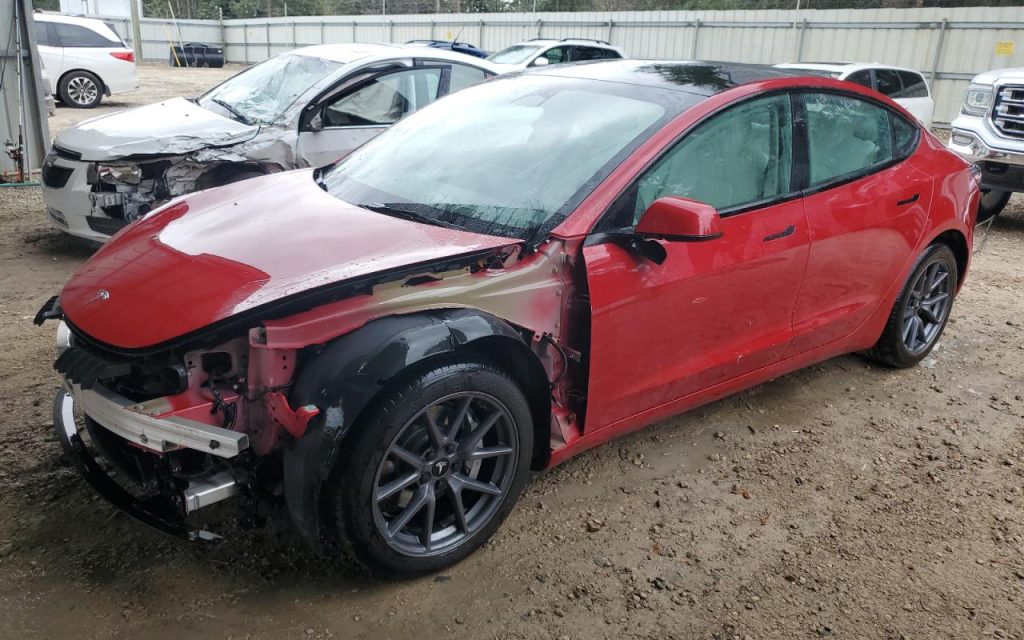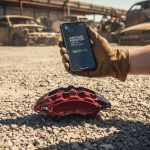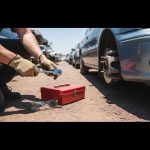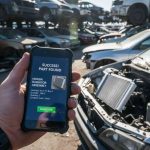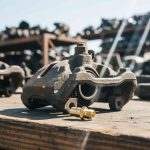Electric vehicles (EVs) are becoming more popular, and as more of them hit the road, some eventually end up in junkyards near you just like regular cars. However, EVs are a bit different, and you need to know some key things about buying and handling their parts. This guide will help you learn about the electric vehicle parts you can find in junkyards, what to look for, and how these parts can help you save money on repairs. Let’s check it out!
Why Electric Vehicle Junkyards Are Different
EV junkyards are different from regular junkyards because they require special skills to handle certain parts, like high-voltage batteries. Not every junkyard is set up for this, but many are learning how to work with these newer cars. Here’s why EV junkyards are unique:
- High-Voltage Skills: Handling EV batteries and motors is tricky. Workers need special training to do it safely.
- Fewer EVs Available: Since EVs are relatively new, there aren’t as many in junkyards yet compared to regular cars.
- Special Parts: EVs have unique components like inverters, battery packs, and electric motors that you won’t find in traditional gas cars.
These differences mean finding used EV parts in junkyards can be harder, but it’s usually worth it because of the money you can save.
Common Electric Vehicle Parts Found in Junkyards
There are lots of EV parts you can find in junkyards, and buying them used can save you a lot compared to buying new ones. Here are some parts you might find:
1. Battery Components
- Battery Modules: These are smaller sections of the main battery that can be reused in other projects or as replacements.
- Battery Management System (BMS): This part helps the battery work properly by controlling how it charges and discharges. You might be able to find these used.
- Cooling Systems: EV batteries need cooling to prevent overheating. Junkyards often have these cooling parts available.
2. Electric Motors and Drivetrain
- Traction Motors: These motors make the wheels turn. Motors from cars that were in accidents can often still work well.
- Inverters: Inverters convert the battery’s power from DC to AC for the motors. A used inverter can save you a lot of money.
- Reduction Gears: These gears control the speed from the motor to the wheels and are often still usable.
3. Charging Components
- Onboard Chargers: These let you charge your EV at home. You can find used ones at a good price.
- Charging Ports: Charging ports can wear out but are sometimes available in junkyards.
- DC-DC Converters: These convert high voltage into lower voltage for other parts of the car.
4. Wear and Tear Items
- Tires: EVs use up tires faster because they have more power. Junkyards often have good tires available for much less money.
- Suspension Parts: Because EVs are heavier, parts like shocks and struts wear out faster. Junkyards usually have these parts in decent condition.
- Windshield Wipers & Cabin Air Filters: These are easy to find and replace from a junkyard.
5. Body and Interior Parts
- Body Panels and Fenders: EVs have some special body parts, like fenders, that protect the wheels and keep the car looking good. Some fenders also have sensors that help with driving. When buying a fender, make sure it doesn’t have cracks, rust, or damaged mounting points. Learn more about buying used car body parts like fenders here. EV-Specific Fender Considerations
- Material Differences: EV fenders are sometimes made of lighter materials like aluminum or composites to save weight. Be aware of this when shopping for a used fender.
- Integration with Technology: Some EV fenders have sensors or cameras for advanced safety features. Be sure to check these parts carefully to avoid damaging anything important.
- Interior Components: Things like floor mats, dashboards, and infotainment screens can often be found in junkyards. Learn more about dashboard parts here.
- Accessory Trays and Floor Mats: These are easy to find and can be cheap to replace.
6. High-Value Components
- Traction Batteries: The big battery packs in EVs are very valuable. Sometimes you can find them to use parts of them.
- Electric Motors: These motors can be reused in other projects or resold.
Why Buy EV Parts From Junkyards?
There are many reasons to buy EV parts from junkyards:
- Save Money: You can save up to 70% by buying used parts instead of new ones. For example, buying used tires from a junkyard can save you a lot.
- Help the Environment: Reusing parts means less waste and fewer items in landfills. Recycling and reusing are really important for EVs.
- Find Rare Parts: Some parts are hard to find, but many junkyards are now focusing on EVs, which makes it easier to find specific parts.
How EVs End Up in Junkyards
Electric cars end up in junkyards for a few reasons:
- High Repair Costs: Sometimes EV parts are very expensive to fix, so insurance companies decide it’s not worth repairing the car. These cars end up in junkyards.
- Battery Problems: If a battery is too costly to fix or replace, the car might get scrapped.
- Accidents: Many EVs end up in junkyards after accidents, but the other parts of the car might still be in good condition.
What to Look for When Visiting an EV Junkyard
- Prepare the Necessary Tools: If the junkyard lets you take parts yourself, bring tools like wrenches, screwdrivers, and gloves. This will help you remove parts safely without damaging them.
- Safety First: Some EV parts have high voltage, so wear gloves and safety gear when dealing with them.
- Know What You Need: Do some research before you go so you know exactly what parts fit your car.
- Call Ahead: Not all junkyards have EV parts, so call before you visit to check availability.
How to Find High-Quality Fenders in Junkyards
Finding a good fender for your EV can save you a lot compared to buying new. Here are some tips:
- Check for Physical Damage: Look for big dents, cracks, or rust. Small scratches can be fixed, but major damage isn’t worth it.
- Inspect Mounting Points: Fenders attach to the car in certain spots. Make sure these aren’t bent or broken.
- Look at the Paint Condition: Try to find a fender that matches your car’s color to avoid repainting.
- Check Compatibility: Make sure the fender fits your car’s make, model, and year. You can check the part number to be sure.
Tips for Finding High-Quality Fenders
- Research Popular EV Models: Fenders for common EVs like the Nissan Leaf or Tesla Model 3 are often easier to find, which means better prices and more options.
- Use Online Junkyard Inventories: Many junkyards have online lists of their parts. This can save you time by helping you find the right fender before you go.
- Consider Professional Inspection: If the fender has sensors, consider having a mechanic inspect it to make sure it’s in good condition.
Removal and Installation Considerations for Fenders
- Safety Precautions: If the fender has electronic parts like sensors, make sure to disconnect the car battery before removing or installing it to prevent any electrical issues.
- DIY vs. Professional Installation: Installing a fender can be a DIY project if you have the right tools and skills, but professional installation can help make sure everything lines up correctly and all electronics are connected properly.
Legal Considerations When Buying Used Fenders
- VIN Verification: Always check that the fender is legally obtained by verifying the Vehicle Identification Number (VIN) and getting a receipt.
- Local Regulations: Some areas have rules about using used car parts, so make sure to check your local laws before buying a fender.
Junkyards Specializing in Electric Vehicle Parts
More junkyards are starting to handle electric vehicles. Here are some you should know about:
- EV Recycling Company (New York): Specializes in EV parts and battery systems.
- Aero Auto Parts (Chicago): Carries many EV parts, like batteries and motors.
- Roscoe’s Junk Cars: Buys hybrid and electric cars to take apart and recycle.
Tips for Finding and Buying EV Parts
- Check Online Salvage Yards and Marketplaces: Websites like eBay Motors, Car-Part.com, and specialty EV suppliers sell used fenders and other parts. These sites can help you find parts in good condition.
- Consider Specialty EV Dismantlers: Some businesses focus only on taking apart EVs. They often have high-quality parts and may even offer warranties.
- Do Your Research: Knowing your car’s model and part numbers can save you a lot of time.
- Check Multiple Places: Prices can vary, so visit more than one junkyard or check online to find the best deals.
- Check the Condition: Always check the condition of the part before buying, especially for things like batteries.
Step-by-Step Guide to Buying a Used Fender
- Identify the Exact Fender You Need: Figure out if you need a right or left fender and note any special features like sensor mounts.
- Search for Junkyards: Find junkyards that carry your car model and call ahead to make sure they have the part.
- Inspect the Fender: Use the tips above to inspect the fender for damage, compatibility, and condition.
- Negotiate Price: See if you can negotiate the price and understand the junkyard’s return policy.
- Install the Fender: Decide whether to install it yourself or hire a professional to make sure it fits properly.
Success Story: Finding a Quality Used Fender
One EV owner shared how they saved hundreds of dollars by buying a used fender from a local junkyard. They called ahead to check for availability, brought the right tools, removed the fender themselves, and had it inspected by a mechanic. The fender fit perfectly and worked great, saving them money and keeping their EV in top shape.
Conclusion
Junkyards are becoming a great place for EV owners to save money on repairs. Whether you need a battery module, an electric motor, or just new tires, buying used parts from a junkyard can save you a lot of money and help the environment. As more electric cars hit the road, junkyards will keep getting more parts, making it easier for you to fix your EV without spending a fortune.
Frequently Asked Questions
1. Can I find electric vehicle batteries in junkyards?
- Yes, but they can be hard to find, and their condition may vary. Specialized junkyards are more likely to have them.
2. How much money can I save by buying used EV parts?
- You can save up to 70% compared to buying new parts, depending on the part and its condition.
3. Are EV parts from junkyards safe to use?
- Yes, but check the condition carefully, especially for high-voltage parts, and be safe when handling them.
4. Do all junkyards have electric vehicle parts?
- No, not all junkyards carry EV parts, but more are starting to. It’s a good idea to call ahead and ask.
5. What EV parts are most common in junkyards?
- Items like tires, suspension parts, 12V batteries, and charging ports are the most common EV parts found in junkyards.
6. How can I ensure a used fender from a junkyard will match my EV?
- Verify the part number, compare the fender’s dimensions, and consult a professional if needed.
7. Is it safe to install a used fender myself?
- If you have some mechanical experience and the right tools, it can be a DIY project. Otherwise, professional installation is recommended.
